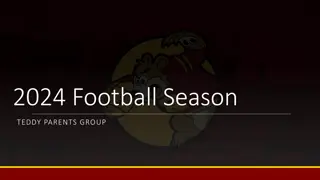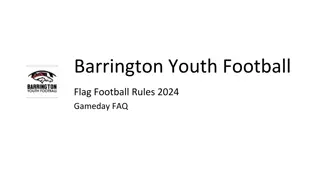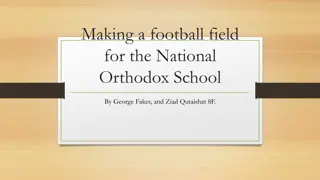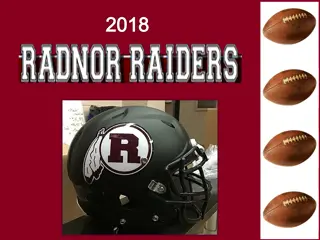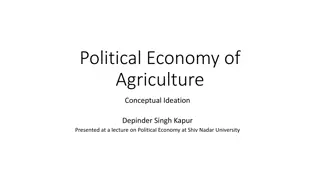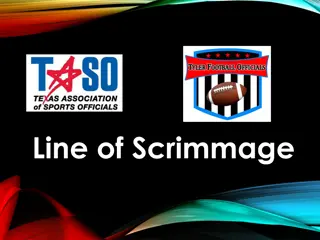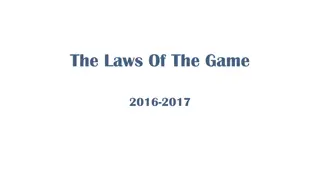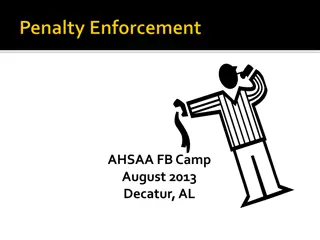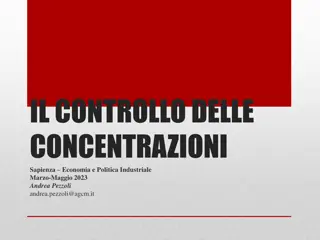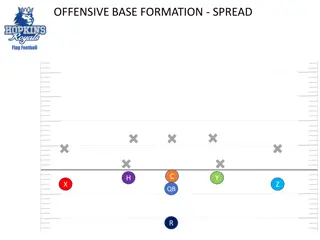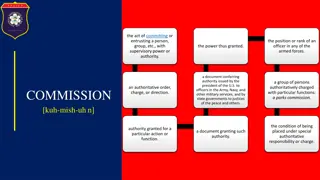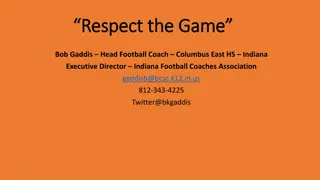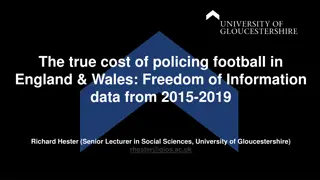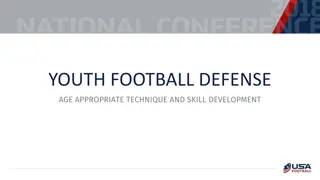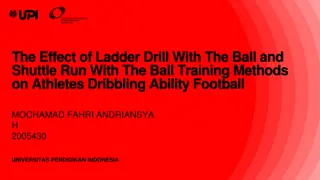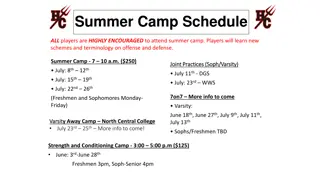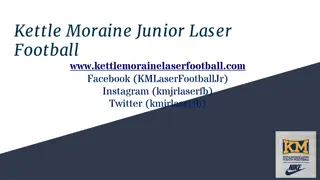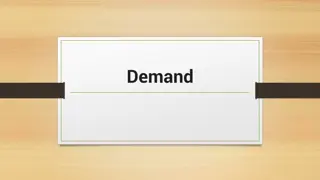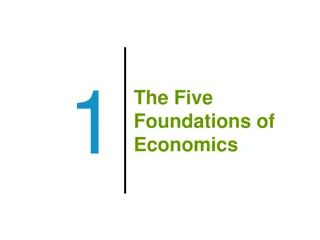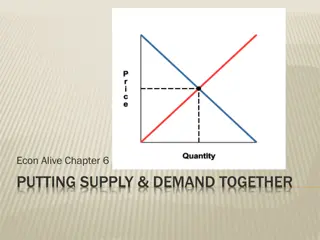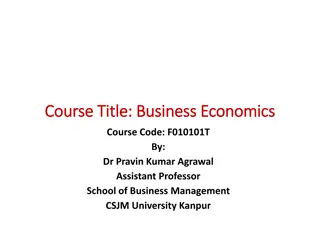Understanding the Market Dynamics of Football Economics
The football market operates on the principles of supply and demand, with owners offering entertainment and access to games while spectators, networks, and merchandisers seek viewing opportunities and commercial rights. Athletes supply labor and seek fair compensation, often working cooperatively through unions to enhance their negotiating power. This dynamic interplay shapes the economics of professional football.
Uploaded on Sep 16, 2024 | 0 Views
Download Presentation

Please find below an Image/Link to download the presentation.
The content on the website is provided AS IS for your information and personal use only. It may not be sold, licensed, or shared on other websites without obtaining consent from the author. Download presentation by click this link. If you encounter any issues during the download, it is possible that the publisher has removed the file from their server.
E N D
Presentation Transcript
Football Economics: The Market for the Game Supply and Demand Basics A market is a series of individual exchanges conducted by pairs of consenting parties for a defined product or service over a specific period of time. For example, the annual market for Super Bowl tickets involves a variety of agents with permission to sell specified tickets seeking buyers who wish to attend the game. The buying side of the market is called demand; the selling side of the market is called supply. In professional football, owners sell entertainment (supply) and spectators buy the opportunity to view or display the game (demand). Meanwhile, owners also buy the services of athletes who wish to play (demand) and trained athletes make themselves available for a price (supply). If owners and players don t come to an agreement, nothing forces them to do so. This is the free market element of professional football. We neither conscript individuals to play the game nor do we force an owner to continue operating the team if she no longer desires to do so. She is free to sell the team or simply close it down. And, the players are free to seek alternative employment. Both of these market exits happen quite often in the NFL. 1
Football Economics: The Market for the Game What do the owners supply? Owners sell access to view a football contest. Over time, this has evolved to be a fully inclusive product covering small, dramatic elements of the player, coaches, and owner s lives as well history and statistics related to the game. Owners ration scarce supply for in-person viewing by charging for seats in the stadium. Owners ration access to television viewing by selling some broadcast rights to the highest bidder. The broadcast company with rights then sells advertising opportunities. Owners make online and cable television viewing available by selling scarce advertising opportunities on cable and web-based venues. 2
Football Economics: The Market for the Game What do the buyers demand? Some spectators demand a live event to enjoy or utilize for entertainment purposes. Some networks demand broadcast television rights to sell commercial time. Some merchandisers demand cable or online commercial time to increase their product sales. 3
Football Economics: The Market for the Game What does athlete supply? Athletes are the key labor resource for professional football. Athletes seek a financial payoff for 1 - 12 years of unpaid training and practice time. Athletes seek high wages to justify the physical difficulty and long-term injury risk of playing football. Athletes seek long-term retirement care due to the hazardous nature of the game. Some athletes respond to non-financial incentives such as billboards and other advertising with their image. Athletes supply the essential input to the owner s entertainment product and these lead them to work cooperatively through a union to increase their negotiating power. 4
Football Economics: The Market for the Game What does the owner demand? Owners seek to purchase labor services from athletes. Owner s labor demand includes: Stars to market Good players to enhance competitiveness Filler players to practice against or provide injury replacements Owners perceive value based on number of plays on the field, number of plays with direct impact on the result of the play, win shares over replacement value, and popularity with the fan base. Owners compensate athletes with upfront signing bonuses, regular pay, deferred pay, performance bonuses, training opportunities, and promotions. 5
Football Economics: The Market for the Game The Law of Demand Football-related products follow the same law of demand as all other goods. Law of Demand: As the price of a good rises, the quantity demanded for the good falls, and as the price falls, quantity demanded rises, all other things being equal (ceteris paribus). Lower costs goods are used as substitutes Marginal Utility declines as the amount of the good increases Definition from Arnold, Microeconomics, 10th Edition 6
Football Economics: The Market for the Game The Market Demand Schedule NFL Jerseys Quantity Demanded Price Fan #1 Fan #2 Other Fans All Fans S140 5 0 1,000 1,005 $120 10 0 25,000 25,010 $100 15 0 100,000 100,015 $80 20 1 225,000 225,021 $60 25 3 350,000 350,028 $40 30 4 675,000 675,034 Fan #1 is an unusually dedicated fan. When the price of an NFL Jersey is $140, he will buy 5 of them. These are probably corporate gifts. So, a prices drop, more employees get an NFL Jersey from the boss. Fan #2 is a little more typical; he waits for the price to fall to a more reasonable level. At $80 he will buy one NFL Jersey, perhaps for himself to wear at home when watching his favorite team. If prices drop to $40, he buys one for everyone in his family. 7
Football Economics: The Trade-offs That Make the Game The Market Demand Curve The Market Demand Curve is the sum of all individual demand curves. Fan #1 Fan #2 All Other Fans Market Demand Curve Price Price Price Price Quantity Demanded Quantity Demanded Quantity Demanded Quantity Demanded 8
Football Economics: The Trade-offs That Make the Game Change in Quantity Demanded Movements along the market demand curve are called changes in the quantity demanded. No other factors changed, only the price. The original price (P1) moves to a new price (P2). Then, the quantity demanded is no longer Q1 but now moves to Q2. Price P 2 P 1 Quantity Demanded 9 Q 2 Q 1
Football Economics: The Trade-offs That Make the Game Shift in Demand Market changes other than price have the impact of shifting the market demand curve. These are called shifts in demand. To demonstrate these, we move the whole line. More of the quantity is demanded at every price. What happens to quantity and price depends on the supply curve. Price Quantity Demanded 10
Football Economics: The Trade-offs That Make the Game Shift in Demand: Market Examples In general, a shift in demand might occur because of the change in price of another good, the changing preferences of shoppers, changes in tax policy, or expectations of future changes related to the product in question. Price D original D increase D decrease Quantity Demanded 11
Football Economics: The Trade-offs That Make the Game Shift in Demand: Football Examples An decrease in NBA Jersey prices would cause some NFL fans to shift to NBA Jerseys, thereby shifting the demand for NFL Jerseys. An increase in the popularity of NASCAR might reduce demand for NFL products. The expectation that a favorite player will be injured for all of the following season will reduce the demand for season tickets. Price Quantity Demanded 12




